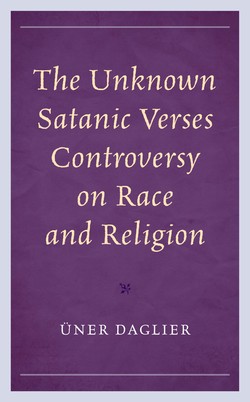Читать книгу The Unknown Satanic Verses Controversy on Race and Religion - Üner Daglier - Страница 11
На сайте Литреса книга снята с продажи.
ОглавлениеPart II
Mahound
The second part of the novel, in a single chapter, critiqued the foundations of Islam, through a reinterpretation of the satanic verses incident, which was recorded in some traditional Islamic histories.1 In these traditional histories, later in time deemed heterodox, the apparent goal was not to discredit the Islamic prophet but to chronicle a human journey, in which he gradually unraveled satanic deception. Rushdie however, like contemporary orthodox Islamic scholarship that sought to suppress the memory of the satanic verses incident, saw an opportunity to cast doubt on the authenticity of the Islamic revelation and subtly reject its divine origin. Nevertheless, some critics have argued that Rushdie’s goal, like traditional chroniclers of the incident, was to humanize the Islamic prophet, as a fallible person in triumphal pursuit of moral truth. This was not altogether implausible because Rushdie’s alleged attempt to reform Islam, as a practical response to social needs, and his existential challenge to it, as an intellectual statement with an eye to the long-term development of humanity, were not mutually exclusive.
For all the hostility against Rushdie’s fictional take on the Islamic religion’s foundations and Muhammad, part II provided a serious and remarkably well-written account of the times, circumstances, and personages surrounding the birth of a great world religion. Thus far, however, largely passed unnoticed in academic circles and public debate, throughout part II Rushdie consistently characterized the Islamic religion as misogynistic to the core. Yet this feminist aspect of part II fit in with the novel’s overall case against Islamic misogyny, or its case against Islam as a religion that needed to reform its gender divisions.
Indeed to the limited extent that it is possible to talk of a concrete organizing principle, Rushdie’s deconstructive diagnosis of Islamic misogyny was the uniting thread of both part II and The Satanic Verses’ other sections on Islam. However, among other things, part II also dwelt on the tension between artistic freedom and political manipulation, albeit briefly, through poet Baal’s politically imposed yet intellectually genuine opposition to prophet Mahound. If anything, Baal’s take on the task of a writer said something about what Salman Rushdie set about to accomplish in The Satanic Verses: “To name the unnamable, to point at frauds, to take sides, start arguments, shape the world and stop it from going to sleep” (SV, 100).2 And advanced variations of these three themes, or the veracity of Islam, its alleged misogyny, and the sharp tension between intellectual freedom and the establishment of a theocratic polity constituted the substance of the novel’s only other part (VI) on the foundations of Islam.
